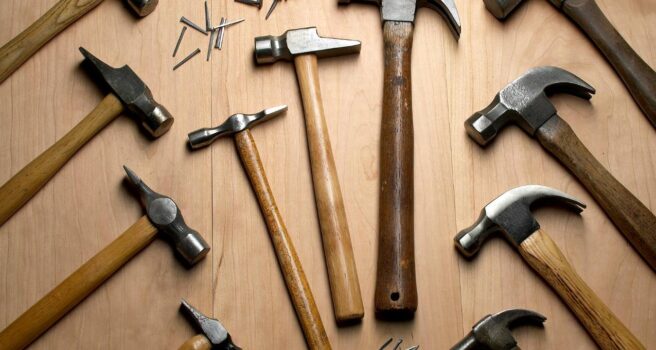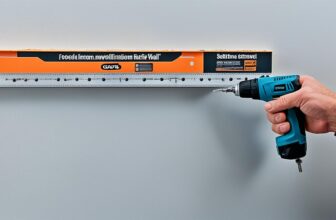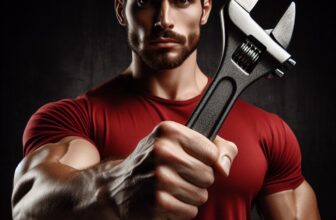Table Of Content
Hammers are possibly the most essential tools for do-it-yourself (DIY) home improvement projects. From hanging pictures and mirrors around the house to building a deck in your backyard, nearly every project relies on some type of hammer at some point. Choosing the right type of hammer for the specific task is key to working efficiently and achieving professional-looking results.
This comprehensive guide covers the basics of hammer anatomy and the various types suited for common DIY scenarios. Whether you need to drive nails into a wall, shape metal brackets, or demolish tile, there is a hammer specially designed for the job. Read on to understand the differences and select the best hammer for your next DIY undertaking.
Understanding the Hammer: Basic Anatomy and Types
All hammers share some common parts in their anatomy:
Disclaimer:
Our recommendations are based on extensive experience with and/or knowledge of these products, and we do so not because of the modest commissions we could earn but rather because we believe they are actually beneficial and useful. We are honored to be these tools' affiliates. We might receive commissions from Amazon, and other merchants when you buy something after clicking one of our links. Our affiliate policy is covered in more detail here. If you don't think these things will help you accomplish your goals, please don't spend any money on them.
- Head – The heavy metal portion used for striking. Made of steel, titanium, brass, etc.
- Face – The surface of the hammer head that strikes the target. Can be flat, rounded, or pointed.
- Claw – Curved section on the back of the head used for nail pulling (in claw hammers).
- Handle – Attached to the head, usually wood, fiberglass, or steel. Provides grip and leverage.
- Wedge – A fitted wedge that secures the head and handles together.
Types of Hammers
Hammers fall into two major categories – general purpose or specialty:
General Purpose Hammers:
- Claw Hammer – Best all-around DIY hammer for driving/pulling nails
The claw hammer is the most popular general-purpose hammer for household DIY projects. It has a metal head with a flat striking surface on one side and a claw on the other. The claw side is used for removing nails, while the flat side drives nails into various materials.
Claw hammers come in a range of sizes, typically weighing between 7 oz for light-duty tasks, and 16 oz for more demanding jobs. The most common size for general DIY work is 14 or 15 oz.
- Ball Peen Hammer – Multi-purpose hammer with rounded “peen” tip for metal shaping
Ball peen hammers have a flat striking face on one end and a rounded ball peen on the other. The flat face is used to strike objects directly, while the ball peen is used to shape metal surfaces.
These types of hammers are popular for metalworking projects like jewelry making, welding, and blacksmithing. Ball peen hammers range in size from 4 oz to over 30 oz.
- Sledgehammer – Heavy hammer for demolition and driving stakes
Sledgehammers have large, heavy heads designed to drive stakes and break up concrete, rocks, or masonry. The large striking surface provides powerful, crushing blows.
Sledgehammers weigh between 10 to 20 pounds, with longer handles (3+ feet) to generate maximum force. The heavy weight makes sledgehammers awkward for precision work.
Specialty Hammers:
There are many specialty hammers designed for specific trades:
- Drywall hammers – Lightweight with sharp edges to cut drywall
- Roofing hammers – Have a hatchet blade opposite the hammer head for cutting shingles
- Brick hammers – Designed to chip brick and concrete blocks
- Upholstery hammers – Lightweight with interchangeable heads for tacking fabric and trim
- Soft-faced hammers – Have rubber, plastic, or leather facings to avoid marring surfaces
- Rubber Mallet – Soft hammer prevents surface damage
Many more specialized varieties exist as well.
Hammer Materials
Hammers are commonly made from various metal alloys, wood, rubber, and other materials:
Steel
Most modern hammer heads are made of drop-forged carbon steel or forged alloy steel. These provide strength and shock resistance when driving nails and hammering.
- Carbon steel – Durable, shock-resistant, and inexpensive but can rust.
- Alloy steel – Stronger than carbon steel and more resistant to rust and abrasion. Common alloys used are chromium, vanadium, and molybdenum.
Titanium
Titanium hammers are exceptionally strong yet lightweight. More expensive than steel but ideal for repetitive hammering tasks. Helps reduce fatigue compared to steel hammers.
Brass and Copper
Brass and copper hammers are softer than steel. Used when a non-marring hammer head is needed to avoid damaging surfaces. Common in upholstery work.
Wood
Wooden hammers, like wooden mallets, are useful when force must be applied gently. The shock-absorbing properties of wood make it suitable for delicate work.
Rubber and Plastic
Hammers with rubber or plastic heads are designed for applications where metal would damage the working surface. Used often in auto-body work.
Hammer Handle Materials
Hammer handles are commonly wood, fiberglass, or steel:
- Wood handles provide shock absorption but can split over time. Hickory is a popular wood choice.
- Fiberglass handles are durable, shock-resistant, and don’t suffer from wood rot.
- Steel handles offer durability for heavy-duty sledgehammers and are unbreakable. Not as shock-absorbent.
The Claw Hammer: A DIY Essential
The claw hammer is the most commonly used type for general household DIY and repair jobs. Its versatility and ability to drive and remove nails make it an essential addition to any homeowner’s toolbox.
What is a Claw Hammer?
Claw hammers feature a flat metal head on one side and a split “claw” on the other:
- The flat face drives nails into wood, drywall, or other materials with force.
- The curved claw grabs onto nails and acts as a lever to pull them back out.
This combination of driving and pulling nails allows the claw hammer to be an all-purpose hammer for basic DIY work.
When to Use a Claw Hammer
A claw hammer can be used for typical household tasks like:
- Hanging pictures, mirrors, or wall decor
- Assembling furniture or cabinetry
- Building shelving units or bookshelves
- Securing loose boards or molding
- Basic woodworking projects
A good claw hammer is designed to drive and extract standard nails with ease. The next section covers what features to look for when selecting a claw hammer for your tool collection.
Ball Peen Hammer: For Metalwork and More
While a claw hammer drives nails, a ball peen hammer is specially designed for shaping and working metal surfaces. The rounded “peen” tip lets you refine curves and angles in metal pieces being bent or welded together.
When To Use a Ball Peen Hammer
Ball peen hammers come most in handy for metalworking tasks like:
- Jewelry making
- Sculpting and molding small metal pieces
- Blacksmithing
- Welding jobs
- Auto body work
These hammers can also be used as a general hammer, but the rounded peen strikes less powerfully or accurately than a flat face. Still, the ball-peen surface will not damage workpieces as much as steel.
Choosing the Right Ball Peen Hammer
Ball peen hammers range widely in size and weight. Consider these factors when selecting one:
- Weight – Heavier hammers provide more striking force. A 16 oz or 24 oz hammer is common for general metalworking.
- Materials – Steel heads drive hardest. Brass/wood heads reduce marring.
- Handle Length – Shorter handles offer more control, longer handles more striking force.
- Head Shape – Rounder peens allow smoother shaping; square peens provide sharper impressions.
The Estwing BPFH250 4-Pound Ball Peen Hammer is a top choice for small to medium metalworking jobs. The polyester handle reduces vibrations while the forged steel head provides durability.
Sledgehammers: For Heavy-Duty Tasks
Sledgehammers are designed for demanding demolition, breaking, and driving tasks that require sheer striking power. These heavy hammers can weigh anywhere from 10 to 20 pounds, delivering enough force to break concrete or drive posts into the ground.
The extra-long handles, measuring over 3 feet in many cases, allow users to take full, powerful swings and generate maximum striking force through momentum. However, sledgehammers’ extreme size and weight also limit their use to only the most heavy-duty jobs.
When To Use a Sledgehammer
Common sledgehammer applications include:
- Breaking up concrete slabs
- Demolishing brick, stone, or masonry
- Driving fence posts or foundation piles into very hard ground
- Bending, straightening, or shaping thick steel
- Crushing rock for landscaping projects
For heavy material removal, demolition, or earth-moving jobs, sledgehammers deliver brute striking force other hammers simply cannot match. Their power comes at the cost of control, however, making them unsuitable for detailed or delicate work.
Specialized Hammers: From Rubber Mallets to Framing Hammers
In addition to the common claw, ball peen, and sledgehammer varieties, there are numerous hammers specially designed for particular industries or DIY tasks:
Rubber and Soft-Face Hammers
Hammers like the rubber mallet and soft-faced hammer have rubber, plastic, leather, or other soft materials covering the striking surface. This softer contact prevents damage to the workpiece or surface. They come in handy when force is needed but marring from metal hammerheads is not acceptable.
Drywall Hammers
Drywall hammers feature a typical flat face on one side, and a pointed slicing hatchet on the other. The hatchet easily cuts into drywall allowing for outlets to be cut out. The hammer end drives drywall nails as usual.
Upholstery Hammers
Upholstery hammers have soft, interchangeable heads perfect for tacking fabric and trim without causing tears or dents. The lightweight design provides a delicate but firm striking force.
Fiberglass and Heavy-Duty Hammers
In recent years, fiberglass hammers have grown in popularity thanks to their shock-absorbing handles and extreme durability:
Fiberglass Hammer Benefits
- Provide more shock absorption and reduce strain on elbows/wrists
- Won’t crack, splinter, or deteriorate like wooden handles
- Resist damage from overstrikes and missed swings
- Lightweight for their size yet still pack substantial striking force
The Craftsman 20 oz Fiberglass Hammer is a great mid-weight choice, while the Estwing 22 oz Framing Hammer model offers a shock-reducing grip and powerful striking force.
Heavy-Duty Hammers
For professionals and demanding DIY jobs, heavy-duty hammers provide exceptional striking force and durability:
- All-steel construction prevents head-to-handle loosening
- Forged or cast steel heads resist damage, chips, and wear
- Extra weight (up to 32 oz) allows powerful swing momentum
- Shock-reduction handles on some models
The Estwing Sure Strike Drilling Hammer is one excellent heavy-duty option made in the USA. Weighing 30 ounces, it tackles tough masonry drilling yet reduces vibration.
Advance your DIY expertise! After mastering hammers, explore a wider array of essential hand tools in our detailed guide. Click here to read ‘Your Go-To Guide for Hand Tools‘ and become a true DIY pro!
Maintaining Your Hammer: Care and Storage
Properly caring for hammers helps them last for years of faithful service:
- Wipe heads clean after use to prevent rust
- Sand any burrs or deformations on the face
- Tighten/replace loose or damaged handles
- Consider rubbing linseed oil on wooden handles
- Store in a cool, dry place to prevent warping or rust
Also, be sure to regularly inspect the hammer head and handle for any cracks or damage that may have developed over time.
How to Use a Hammer Properly
Using proper hammer technique is vital both for efficiency and safety:
Choose the Right Hammer
A claw hammer is suitable for most light household uses. Select a larger sledgehammer for heavy demolition or masonry work. Use a specialty hammer suited to specific trades.
Inspect for Damage
Inspect the hammer head and handle before use. Cracked or loose hammer heads can break off and cause injury. Split or cracked handles should be replaced.
Hold Correctly
- Grip the handle toward the end for better control
- Keep wrist straight to avoid injury
- Choke up for light swinging; slide down for heavy blows
Swing from Elbow
Generate force by swinging with the elbow, not just your wrist, to drive nails efficiently and accurately.
Strike Squarely
Hit nails and surfaces squarely. Glancing blows tend to bend nails and cause the hammer head to chip.
Pull Out Nails
Use the claw on the back of a claw hammer to remove nails. Pry under the nail head and lever it out.
Proper hammer usage protects you from harm and helps complete DIY projects effectively. Follow these guidelines to get professional-looking results.
Safety Considerations When Using Hammers
While extremely useful tools, hammers can also be dangerous when handled carelessly or without the proper precautions:
- Always wear safety goggles – nails and debris can fly off
- Use proper gripping and swinging techniques to avoid losing control
- Ensure the work area is free of any tripping or slipping dangers
- Never use a hammer with a damaged, loose, or splintered handle
- Avoid hammering nails where children may be within striking distance
- Consider wearing gloves and steel-toe boots for added protection
- Take breaks during prolonged hammering to rest wrists and elbows
Following basic safety practices will prevent many common hand and eye injuries when using hammers.
DIY Projects: Examples of Hammer Applications
Hammers play a pivotal role in nearly any home improvement project. Here are just a few examples:
Hanging Pictures and Wall Decor
A claw hammer allows you to tap nails into drywall or plaster walls to hang framed photos, mirrors, shelves, and other wall decor. Choose an appropriate picture hanger and nail for the weight being supported.
Building a Deck
Outdoor DIY projects like building a wooden deck rely heavily on hammers. Use a framing hammer to drive structural nails and screws through deck boards into joists and beams. A rubber mallet helps tap deck boards snugly together.
Assembling Furniture
Ready-to-assemble furniture from stores like IKEA often requires a claw hammer and/or rubber mallet. Tap connector bolts, cam locks, and other hardware to assemble cabinets, tables, beds, and shelving kits.
Sculpting and Molding
For metalworking artists and hobbyists, a ball peen hammer is perfect for precisely shaping curves, textures, and details on sculptures, molds, jewelry, and more. The rounded peen allows fine-tuning bends.
These are just a sampling of the diverse DIY applications hammers have around the home, garage, and workshop.
Conclusion
From driving nails to bending metal, hammers are invaluable, versatile tools for home DIY projects. With an understanding of the different types of hammers, and selecting the best one suited for the job, tackling repairs and improvements around the house is made far easier. Be sure to also use proper safety precautions like goggles and gloves during use. Equipped with the right knowledge and tools, your next DIY endeavor is sure to be a success!








